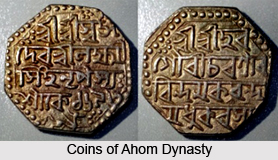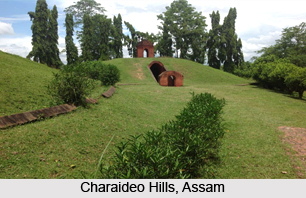 Sudoiphaa, also known as Tej Singha, was an Ahom king who reigned in the kingdom from 1677 CE to 1679 CE. He was installed on the throne by the Prime-Minister of Ahom Kingdom, Atan Burhagohain, after disposing the former king Sujinphaa. His rule was marked by the decline of dictatorship of Atan Burhagohain followed by the rise to the power of Laluksola Borphukan, the Ahom Viceroy of Guwahati and Lower Assam. Sudoiphaa had put much effort to end the atrocities of Laluksola Borphukan and re-establish his own authority which ultimately resulted in his own disposition from the throne.
Sudoiphaa, also known as Tej Singha, was an Ahom king who reigned in the kingdom from 1677 CE to 1679 CE. He was installed on the throne by the Prime-Minister of Ahom Kingdom, Atan Burhagohain, after disposing the former king Sujinphaa. His rule was marked by the decline of dictatorship of Atan Burhagohain followed by the rise to the power of Laluksola Borphukan, the Ahom Viceroy of Guwahati and Lower Assam. Sudoiphaa had put much effort to end the atrocities of Laluksola Borphukan and re-establish his own authority which ultimately resulted in his own disposition from the throne.
Coronation of Sudoiphaa
Sudoiphaa was the member of Parvatia branch of Ahom dynasty and was originally known as Khamcheo. Parvatia Deka Raja, the son of the founder of Parvatia branch Prince Sukrang, was his grandfather. His early life was spent in agricultural activities and he dwelled near Charaideo hills. In 1677 CE Swargadeo Sujinphaa and Atan Burhagohain got involved in a conflict and the latter emerged as victorious. Although the nobles pressed the minister to take over the throne, he refused owing to the Ahom tradition where only the royal members of the dynasty can become the king. Thus after a vigorous search he coronated Khamcheo as the new monarch and the Tai Ahom priests named him Sudoiphaa while the Hindu priests named him Tej Singha. He was also popular as Parvatia Raja as he dwelled in Charaideo Parvat previously.
Reign of Sudoiphaa
After being coronated, Sudoiphaa married several wives belonging to his supporter families, including the daughters of Atan Burhagohain and Laluksola Borphukan, for strengthening his political alliance and support. The king was much grateful to Atan Burhagohain as he raised him to the throne and also bestowed a number of gifts on him including ornaments, sedans, golden trays, carpets, swords and lands in Charaideo hill, elephants and horses and an estate in Dulung. His wife was also honoured with valuable gifts including a sedan which can only be used by the nobles and royal members. On the advice of Atan Burhagohain, the king also promoted adherents of Atan Burhagohain to higher powers.
Discontent of Nobles for Sudoiphaa
 Although Sudoiphaa and Atan Burhagohain shared an amicable relationship for a certain period, it started deteriorating later. As per the Ahom customs, the nobles used to pay their homage to the king and his consort by prostrating seven times. However once, when Atan Burhagohain arrived, one of the wives of the king who also happened to be the daughter of Burhagohain left the court unwilling to see her father prostrating. This was also followed by other nobles and consequently no one was left to receive the homage. This was not appreciated by the monarch harbouring suspicion about Atan Burhagohain, which upset the latter when reported to him by his daughter. This was followed by another trouble in which the daughter of Mecha Borbarua who was also the wife of Sudoiphaa became the favourite of her husband and thus started showing discourtesy to Atan Burhagohain. She also appointed new officers dismissing the old ones.
Although Sudoiphaa and Atan Burhagohain shared an amicable relationship for a certain period, it started deteriorating later. As per the Ahom customs, the nobles used to pay their homage to the king and his consort by prostrating seven times. However once, when Atan Burhagohain arrived, one of the wives of the king who also happened to be the daughter of Burhagohain left the court unwilling to see her father prostrating. This was also followed by other nobles and consequently no one was left to receive the homage. This was not appreciated by the monarch harbouring suspicion about Atan Burhagohain, which upset the latter when reported to him by his daughter. This was followed by another trouble in which the daughter of Mecha Borbarua who was also the wife of Sudoiphaa became the favourite of her husband and thus started showing discourtesy to Atan Burhagohain. She also appointed new officers dismissing the old ones.
Assault on Sudoiphaa
Although a cordial relation was maintained between Sudoiphaa and Atan Burhagohain, the associates of the latter were unhappy and insecure about the situation. Meanwhile the king encountered an assault by Chikan Tamuli, the son of an associate of Atan Burhagohain. Sudoiphaa escaped the attack and Atan Burhagohain along with his nobles tried to convince the king about the involvement of Mecha Borbarua in the attack. After much investigation, Jadu Tamuli, an attendant of Mecha Borbarua, was held responsible and was executed along with some other suspects.
Secret Pact against Sudoiphaa
Sultan Azamtara was appointed by the Mughal Emperor Aurangzeb after 1676 CE for the recapture of Guwahati from the Ahoms. Sultan Azamtara sent a warning message to Laluksola Borphukan about dire consequences in case of refusal which was forwarded to the king and Atan Burhagohain. The demands were however refused by Atan Burhagohain along with a sharp reply. During this phase Mecha was held captive by Laluksola Borphukan in the charge of murder attempt of the king. Atan Burhagohain however demanded his release which was refused by Laluksola Borphukan resulting in sour relation between Atan Burhagohain and Laluksola Borphukan. However Atan Burhagohain avoided any internal conflicts in the kingdom owing to the fear of possible outbreak of war with the Mughals any time. But on the other hand Laluksola Borphukan got insecure about his safety and forwarded a proposition to the Mughals. He expressed his wishes to evacuate Guwahati for the Mughals and in return demanded their assistance for installing himself as the king of Assam.
Rise of Laluksola Borphukan to Power
Although the deal between the Mughals and Laluksola Borphukan was kept secret, some of the officers leaked the news to Atan Burhagohain. The latter then suggested the king to build a fortification near the capital Garhgaon to defend Mughal invasion. It was named as Chintamani rampart. In 1679 CE Mughals captured Guwahati with the assistance of Laluksola Borphukan. Laluksola Borphukan then reached to Sudoiphaa and informed him about the Mughal invasion, hiding about his own role in the scenario and the king ordered his nobles to defend the attack leaving behind the construction work of Chintamani rampart. Owing to the deceiving acts on the part of Laluksola Borphukan which was followed by a fierce battle between the Mughals and the Ahoms, Mughal restored their rule over Guwahati and took Atan Burhagohain as captive. After the battle, the scared king Sudoiphaa fled to his ancestral village Charaideo hills. On assurance of Laluksola Borphukan he returned back to the capital where he was met by Laluksola Borphukan and was explained about the dissatisfaction of the latter due to the maladministration of Atan Burhagohain. Following this, with the consent of the king Laluksola Borphukan appointed his brother Marangi as Borbarua and his other associates in powerful positions.
Death of Sudoiphaa
Although a temporary reconciliation surfaced between Sudoiphaa and Laluksola Borphukan, the premier once again began to re-establish his rule by arresting and removing the adherents of the latter. He also arrested Marangi Borbarua after discovering his secret alliance with the Mughals. When Laluksola Borphukan came to know about the scenario, he provided false assurance to the king about supporting him and decided to dispose the monarch. Thus Laluksola Borphukan marched towards the capital with his adherents and forcefully deposed the king and placed him as a house-prisoner at the palace. A prince of the Samuguria branch was then installed on the throne and was titled as Sulikphaa by the Tai Ahom priests and Ratnadhwaj Singha by the Hindu priests. He was just fourteen years of age at the time of coronation. Later, on the orders of the new king, insisted by Laluksola Borphukan, the disposed king Sudoiphaa was taken to Charaideo hill and was executed by making him to drink poison. His two sons were also executed afterwards.



















